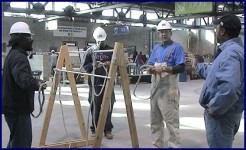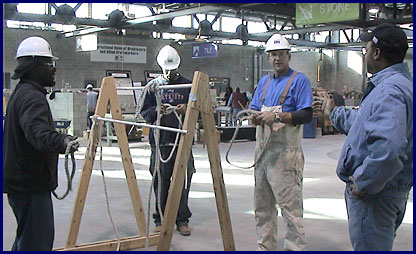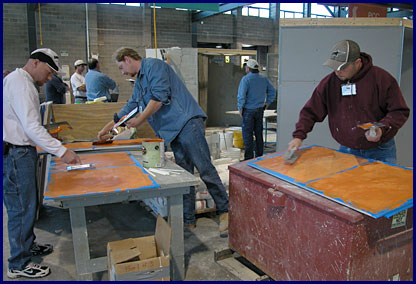Certified Training
By Hazel Bradford
Quality masonry craftsmanship doesn’t just happen. It comes from rigorous training. For union masonry, high training standards are upheld through the industry’s only trainer program, the Instructor Certification Program (ICP) of the International Masonry Institute (IMI), a strategic alliance of the International Union of Bricklayers and Allied Craftworkers (BAC) and their contractors.
ICP covers all the crafts represented by BAC: restoration, brick, tile, terrazzo, stone, marble, cement and plaster.
The overall goal of ICP is to hone instructors’ skills in masonry and teaching. Courses fall into three main categories: professional teaching; technical skills; and materials and practices. Instructors must demonstrate mastery of course content and present a comprehensive training materials portfolio.
The wide-ranging curriculum covers everything from new materials and building codes to adult learning principles and computers. Each year, it is updated to reflect industry trends and market demands.
As they gather to learn the latest developments in the masonry and teaching professions, instructors from all over the BAC/IMI training network also get the valuable opportunity to network with colleagues and compare regional techniques and strategies.
A highlight of the 2007 session was test-driving the John J. Flynn International Training Center, which opened last fall in Bowie, Md. The new, $30 million campus named in honor of John Flynn, BAC’s president, offers training to all BAC members at all stages of their careers, along with education programs for contractors, designers and others.
For this year’s ICP participants, that meant experiencing all BAC crafts in one place, which was a treat for the instructors, since some continue to work their crafts in the field, but may not have had much exposure to other crafts.
Other highlights of the 2007 ICP session were hands-on experience with mast scaffolding, and classes on optimal use of the IMI training management database.
Another informative class covered codes and standards through lectures, reference materials and mockups demonstrating both the technical requirements and workmanship quality issues behind codes. Having a good grasp of that is important, says Clyde Wilson of BAC Local 1 Maryland/Virginia/District of Columbia. “We need to teach that to our students to maintain quality,” he says.
Joseph Alston, a brick instructor from BAC Local 1 NY, values the solidarity of gathering with fellow instructors from all over the country, as well as practical classes like blueprint reading. He also benefited from the courses on teaching styles, which he says have helped him deal with mindsets of older students. Andy Kwiecien, a PCC instructor in Chicago, says he relies on ICP to help him communicate with multilingual students who bring a variety of learning styles and personalities.
Graduate James Feagin, who teaches brick for BAC Local 4 in California but sees all the trades as a construction inspector for the city of Los Angeles, notes, “no matter how good you are, you can always get a tip.”
Perhaps the most dramatic proof of the program’s value is in the graduates who return each year to keep themselves — and their students — sharp. As instructor Pete Cano from BAC Local 3 Arizona/New Mexico/Texas says, “ICP brought me into a new world of teaching.”
Hazel Bradford is director of communications for the International Masonry Institute (IMI). The IMI is a strategic alliance of the International Union of Bricklayers and Allied Craftworkers and their signatory contractors, providing skilled craft training and technical assistance to the design and building communities.



